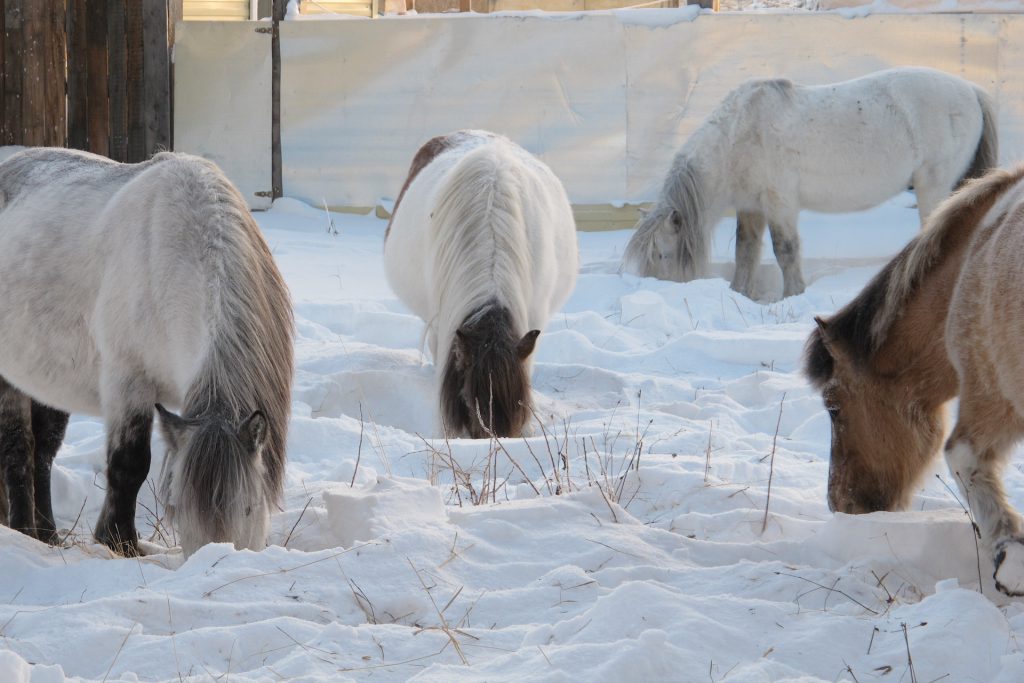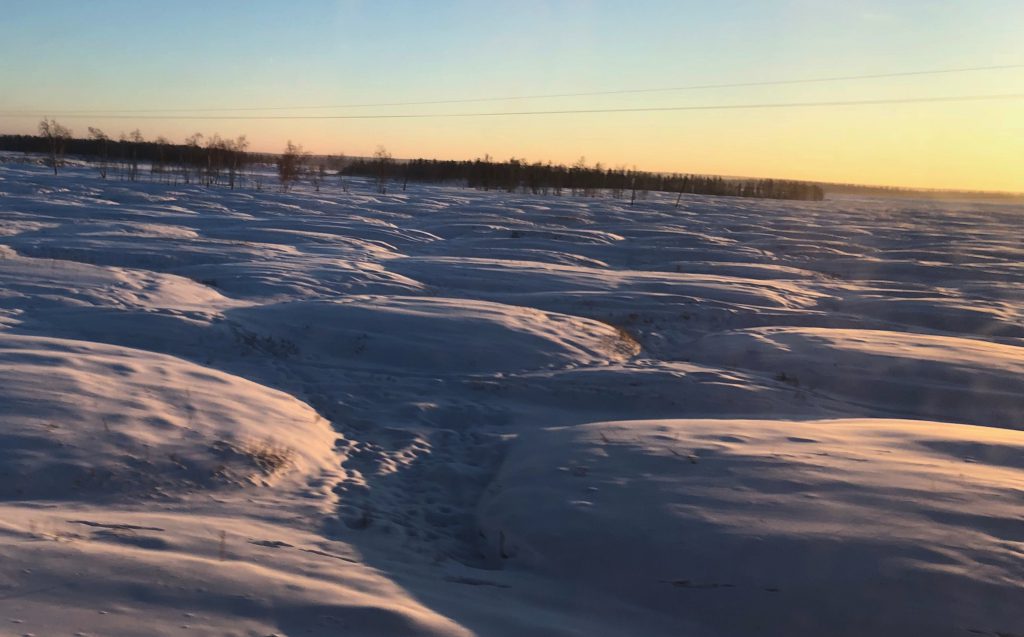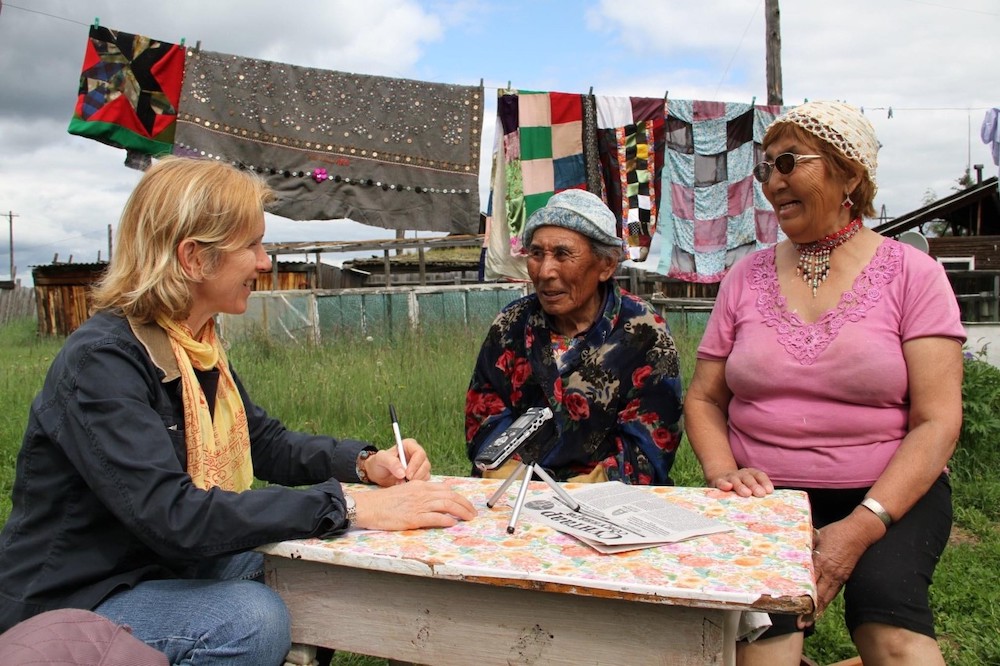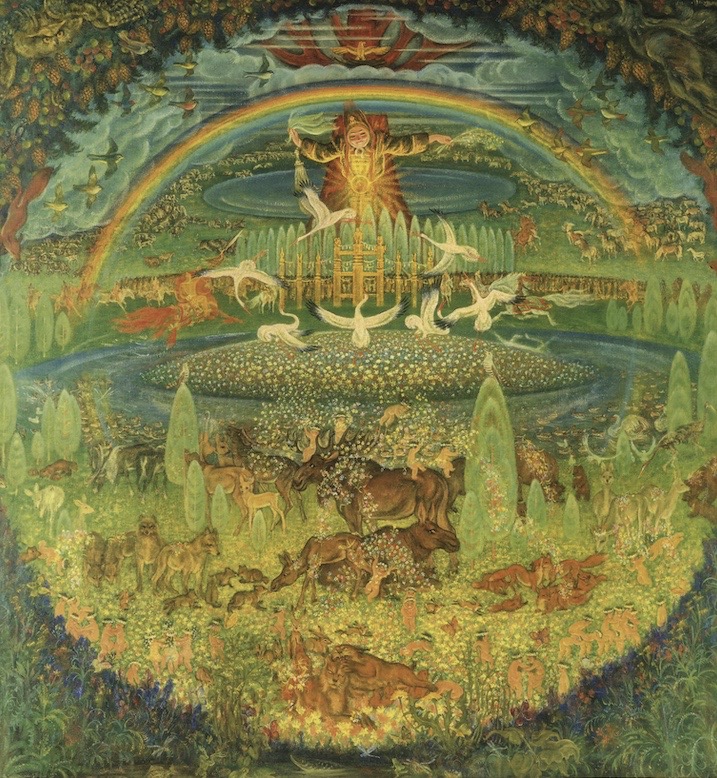We All Live on Permafrost

One of the most distinct memories from my first winter in the Sakha Republic of northeastern Siberia, Russia, is how horses grazed in the minus 50-degree Celsius winter. It was 1993, and I lived in Elgeeii on the banks of the Viliui River. Driving to the next village one day, I found myself transfixed by a group of horses in a wide field rhythmically digging under the snow. They moved continuously.
It was not until 2005, when I began documenting the life history of Valerian Yegorovich Afanaseev, a sylgyhyt (professional horse breeder), that I learned the intimate connection horse breeding has to Sakha’s extreme ecosystem. Each meeting since then he has repeated the same mantra: “Khaar sylgy jiete,” or “Snow is horses’ home.”
What does this phrase mean exactly?
One of the keys to survival for horses in this frigid environment is kencheeri (literally translated as “aftermath”), which is the grass that grows after the July hay harvest by Indigenous Sakha communities. Kencheeri stays green under the snow and is what horses dig for.
Valerian explained that before climate change, kencheeri could be found all winter and provided horses their main nutrition. Now kencheeri rarely grows due to droughts or floods in late summer, both of which are further exacerbated by an elongated fall season characterized by freezes and thaws. No kencheeri means horses need supplemental feeding earlier in the winter months.
Another key to the horses’ survival is their constant movement: Digging and grazing across the fields generates the heat the horses need to withstand the winter. The risk of freezing has further intensified due to increasingly bitter and strong winds brought on by climate change. Horses now seek shelter from the wind in the adjacent forest, where they stand hungry and cold, growing sickly.
“Horses need 30 to 40 centimeters of snow to work and dig so they don’t freeze,” Valerian explained. “If the snow is less than that, they can’t work, and they go from place to place and get thin.”
Valerian yearns for the past, when kencheeri grew well, the temperature changed gradually as fall moved to the deep cold winter, about 30 centimeters of snow fell in autumn and stayed on the ground, and the winter proceeded with no wind.
Valerian’s life history makes real the contemporary experience of Sakha horse breeding: Horses can no longer survive the winter like they used to. Breeding horses depends on specific seasonal and climatic conditions—most importantly, the exact quantity and quality of snow, the horses’ home.
Valerian’s is one of many life histories I have documented during my 30 years of ethnographic research with Viliui Sakha, Turkic-speaking horse and cattle breeders of northeastern Siberia. Such narratives reveal the intimate adaptive relationships between human and nonhuman animals within the context of one of the most extreme inhabitable ecosystems on the planet.
The changes witnessed by Valerian and my other life history collaborators are but some of the indicators of a larger monumental change that is rapidly transforming life as many Siberian inhabitants know it: The thawing of the permafrost, the frozen layer meters below the land’s surface, which is the foundation of all life.
My readers who do not make their homes on permafrost may lose interest at this point. However, consider this: The direct and enduring interdependencies between our planet’s patchwork of biological and cultural systems means that permafrost’s demise is in all of our backyards. Permafrost provides one of the main structural foundations for Arctic ecosystems, which, in turn, work with other ecosystems to maintain planetary balance.
In short, we all live on permafrost. Therefore, its loss matters to us all.
I am an environmental and cognitive anthropologist, which means that I study how humans interact with and think about the rest of the natural world. In my work with anthropogenic climate change, I endeavor to bring what I understand about others’ ways of knowing the world into the scientific and policy realms. I forefront Sakha people’s intimate expertise, or Indigenous knowledge, of their environment to show the importance of engaging multiple knowledge systems in understanding culture and climate change across the global context.
Ultimately, my goal is challenging the hegemony of scientific knowledge and neoliberal “solutions” to climate change by bringing to light the depth and breadth of different ways of knowing the world. My central tenet: We need to engage all relevant knowledge systems to find enduring solutions to our shared predicament. This includes revaluing and repatriating Indigenous knowledge and local knowledge systems, both through policy changes and Indigenous activism, within a world from which they were systematically disqualified and subjugated.
Since most climate change science has focused on quantitative scientific data, my research has not always been an easy sell.
For instance, from 2017–2019, I served as a lead author for Chapter 1 of the Intergovernmental Panel on Climate Change’s Special Report on the Ocean and Cryosphere in a Changing Climate (IPCC-SROCC). At first, most of my natural scientist co-authors seemed chagrined by my presence as an anthropologist. What could I possibly contribute to the report? But after collaborating with two other social scientists for six months, we were able to convince our natural scientist co-authors of the value and relevance of highlighting other knowledge systems that have historically been left out of global climate change discussions.
Changing how scientists and policymakers consider local knowledge and Indigenous knowledge is but one step of many that are needed to relinquish the hegemony of science toward a more inclusive world. In my work, this means translating other ways of knowing the environment into a form that makes sense to scientists, policymakers, and the wider public.
During my 2005 fieldwork, I interviewed Sakha elders about the environmental changes they were seeing. Notably, 10 of the 33 mentioned how Jyl Oghuha, the Bull of Winter, was no longer arriving.
I knew that Jyl Oghuha—a blue-spotted white bull with horns—was responsible for the weather between mid-December and mid-March. With his frosty breath, he brought frigid temperatures (minus 60 to minus 65 degrees Celsius)—and a windless still, too cold for snow to fall. Sakha’s animistic and shamanistic cosmology sees the world as sentient and embraces the personification of many elements of daily and seasonal change. The fact that Sakha people’s way of knowing seasonal change, encapsulated in the narrative of Jyl Oghuha, no longer held true stood out to me.
We need to engage all relevant knowledge systems to find enduring solutions to our shared predicament of climate change.
Would Jyl Oghuha no longer be relevant in making sense of the annual seasonal changes that Sakha had known since their Turkic ancestors arrived in their northern home over 500 years ago? Would it now be a way to talk about the climate past? These and other questions flooded my mind.
At that time, scientists talked about adaptation to climate change in terms of finding ways to accommodate shifts in the physical realm. What scientists had not yet investigated were the cultural implications of unprecedented change.
That question has informed my research to this day—and it’s growing even more urgent with the increasing progression of local changes due to climate change.
Consider the example of the alaas, a term for a wide-open area that includes hayfields, pasture, a lake, and nearby forests for foraging. Sakha’s Turkic ancestors settled on the many alaas dispersed across the vast tundra, using their abundant resources for their horse and cattle subsistence.
This all changed during the Soviet period (1917–1992) when inhabitants were forced to resettle in dense settlements and raise horses and cattle on collective farms. Although this period moved Sakha away from their physical alaas, most Sakha continued to maintain a spiritual link. These relationships with alaas continue in the current post-Soviet period.
But today Sakha watch their alaas transforming before their eyes.
When I asked Yegor Yegorovich Treytyakov, an expert hunter and another life history collaborator, about the changes he’s seen, he told me: “In almost all the alaas areas, where the ötökh (places of old homesteads) were always very flat, the land surface is now rolling and wavy.” He remarked that these changes were due to the thawing of the permafrost. “We Sakha have started to call it abaahy üngküüleebit (where evil spirits danced),” he added, conveying Sakha’s understanding of the sentience of the land.
Sakha know that this rapid change is happening because they hay and forage in the outlying alaas areas and make annual pilgrimages to their birth alaas. Nevertheless, in the face of the rapid physical changes of alaas, Sakha maintain their deep cultural identification with these places.
Another life history collaborator, Margarita Ilyinichna Zabolotzkaya, a village medic and practitioner, explained: “We are children of the alaas. … Every Sakha has an alaas in their spirit—and we carry that alaas with us all our lives.” Margarita explained that this relationship with the alaas went beyond the physical and into the spiritual and ancestral realms.
“Our ancestors lived by the alaas, the round fields with forests shaped like an alaaji (small round pancake) with a lake,” Agrafina Vasilyevna Nazarova, a veteran preschool teacher, told me. Agrafina described the alaas as “a small world in and of itself” and a “birthplace” where a person could find fish and game, pasture and hay, and berries—everything needed to live.
These carefully articulated testimonies cast the alaas as an otherworldly place imbued with a lush, abundant, and vibrant nature. Yes, alaas is a physical place, but it is also a sacred vow with the ancestors—an entangled, interdependent set of relationships between human and nonhuman animals, plants, lakes, glades, and spirits.
Sakhas’ identity is founded upon their intimate human-environment relationship with alaas. What are the implications when they lose their alaas?
Across the planet, communities are witnessing the transformation of their significant cultural places, similar to how Sakha are losing alaas. What can forefronting these ways of knowing bring to the table in global climate policy configurations?
Botanist and Indigenous scholar Robin Wall Kimmerer offers her reflections on the matter in Braiding Sweetgrass. She contemplates the “energetic reciprocity” between the complementary colors of purple asters and goldenrod, likening it to the complementarity of Indigenous knowledge and scientific knowledge.
“Its wisdom is that the beauty of one is illuminated by the radiance of the other. Science and art, matter and spirit, Indigenous knowledge and Western science—can they be goldenrod and asters for each other?”
As humans, we live interdependently within not only a planetary biosphere but what anthropologist Wade Davis terms the “ethnosphere,” or “the sum total of all the thoughts, dreams, ideals, myths, intuitions, and inspirations brought into being by the imagination since the dawn of consciousness.” Our common future depends not only on ameliorating the biophysical consequences of climate change but also on facilitating multiple cultural transformations, with a greater awareness of how different peoples are affected by and responding to unprecedented change.
We need both the goldenrod and the asters.
Metaphorically speaking, we all live on permafrost. Only by integrating scientific knowledge with Indigenous knowledge and local knowledge can we fully grasp the depth and breadth of our common plight and have any hope of finding our way out of the existential crisis of climate change.




































